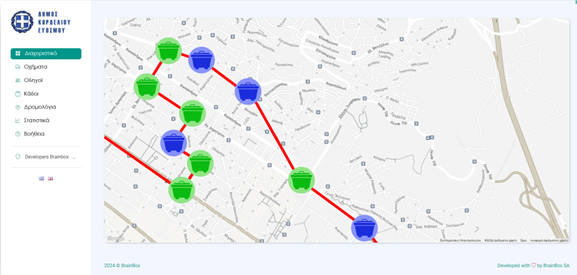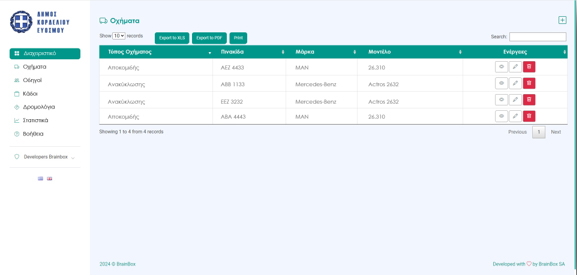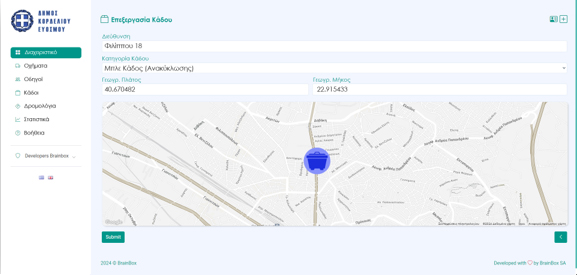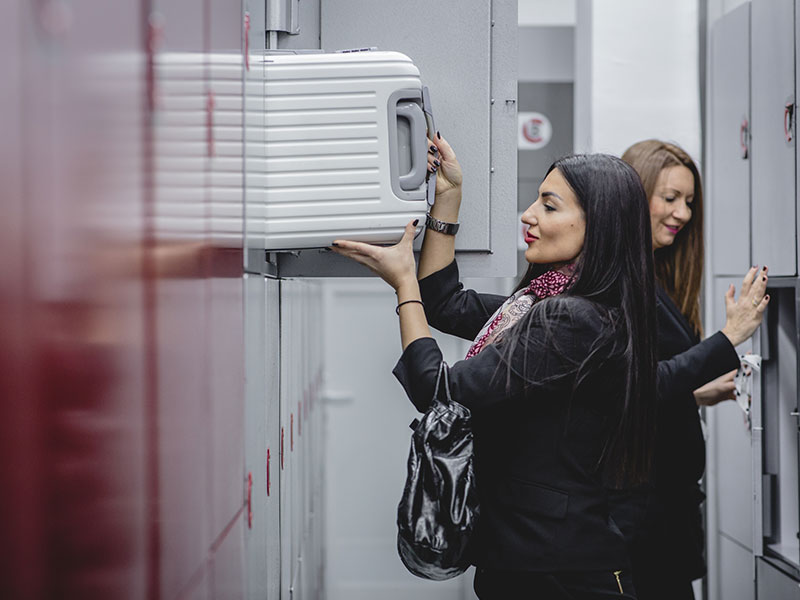Unified information management system

Unified information management system
A management information system is a single platform that interacts and brings together subsystems that serve the needs of an organization. The subsystems communicate with the single platform and are managed from one point. The unified management information system has the following information/capabilities:
- Parking control system management
- Management of bin fullness control system
- Management of electric vehicle charging stations
- Management of digital information boards
- Open City Software Management for PWDs
Parking space control system

BrainBox Integrated Parking Control System is a software used to manage and control parking spaces in urban areas. Its purpose is to improve the use of parking spaces, reduce traffic congestion and make it easier for drivers to find available spaces.
How it works:
The system combines technologies to collect data and monitor parking space availability in real time. This data is provided to drivers via a mobile phone application or website or roadside information systems, helping them quickly find available parking spaces.
Main elements of the system:
- Parking space sensors or position detection cameras: Sensors are placed in each parking space to detect if a space is occupied or available while cameras monitor a street or area.
- Mobile app: Through an app, drivers can see in real time what parking spaces are available in their area or in other areas of the city. The application offers on-line payment possibilities for parking or for reserving a place.
- Information signs (optional): At various points on the roads, digital signs are placed that inform drivers about available parking spaces in nearby areas or parking lots.
- On-line payment capability: The system allows online credit card payment for parking via apps, reducing the need for physical tickets or payment machines. However, it also supports payment by card.
- Backoffice system: The information system provides the operator with a complete picture of the controlled parking by providing details of places, legal and illegal occupations, flow and calls.
- Policing application: The application for mobile phones enables the municipal police to automatically check legally or illegally occupied parking spaces. It is possible to directly impute a fine and to interface with AADE.
Benefits:
- Reduced time searching for a parking space: Drivers easily find available parking spaces without having to circle the streets.
- Reduce traffic congestion: Reduces traffic from cars looking for a parking space, helping to decongest the roads.
- Efficient management of parking spaces: Authorities can monitor the use of parking spaces and optimize their management, e.g. in busy areas.
- Better compliance: Drivers pay more easily and promptly for parking, reducing violations.
- Efficient operator staff management : With automation, the time required by staff supervising parking is minimized and the process is automated
- Control of operation: The system provides complete statistics on parking and violations by analyzing the operation of the service in order to further optimize it.
Waste bin fullness control system

Waste bin fullness control system
The bin occupancy control system includes sensors for measuring occupancy as well as special software for online monitoring of the system, which is a subsystem in the single “smart city” and sustainable mobility platform.
The system works specifically for use in an organized urban environment (Municipality) and includes a mobile phone application for the garbage truck driver, access to route selection, bin status display and update, back office software for system administrators to have access to the data of executed procedures (garbage collection, washing of bins, etc.), but also for the organization of vehicles, drivers and bins, in order to automate bin cleaning procedures.
This is a system necessary to fully organize and monitor the cleaning of the Municipality’s bins, by the waste vehicles that the Municipality has.
The development of the system is by BrainBox Technology SA, a company with a large number of integrated intelligent software solutions, throughout the country.
What does it consist of?
The system described includes the necessary software and equipment, which are recommended for organizing the cleaning of the Municipality’s bins.
- Web-Based System Management Software, through which the overall management and operation monitoring of the Municipality’s bin cleaning system will be done.
- Application on mobile phones to monitor the cleaning fleet
- Telematics devices, installed in the cleaning vehicles, through which the location of the vehicle will be recorded and the bins will be automatically identified
- RF ID tags, installed in the bins
- Readers of RF ID tags, installed in the cleaning vehicles
- Driver cards and driver card readers, installed in cleaning vehicles
The management software (backoffice) takes care of the complete and orderly operation of the system and provides possibilities to organize vehicles, routes, drivers and bins, as well as usage information, geographic locations and on-line monitoring of the system.
The management software is a single system for the overall management of the Municipality’s bin cleaning system. It offers the possibility of remote monitoring of the system at any time and makes sure that the entire system works smoothly and uninterruptedly.
The system will maintain full bin cleaning statistics, issue statistics on both bin status and drivers, routes and vehicles.
The sensors (when required) are special control equipment, which are installed inside each bin in order to measure its fullness.
Electric vehicle charging system

Electric vehicle charging system
The electric vehicle charging system is the infrastructure and technology that allows the charging of electric vehicle batteries (EVs) through electricity.
The system includes dual outlet public electric car charging stations (chargers). With this system, an entity (Municipality, Ministry or a private company) can operate a public electric vehicle charging service for citizens, visitors to a city, or employees of a company that owns electric cars, contributing to the spread of environmentally friendly ways of driving and raising public awareness of the benefits and advantages of electric mobility. The supply of charging stations comes with RFID cards with which users can charge their vehicles. At the same time, BrainBox SA through its affiliated company eVplus provides the most comprehensive platform for managing the electric charger network in Greece.
The charging system includes equipment to provide:
- Level 2 Charging (Level 2): Provides faster charging than level 1 and uses special 240V sockets (similar to those for large household appliances). Level 2 chargers are usually installed in homes, offices and public parking lots and can charge the vehicle within a few hours.
- DC fast charging (Level 3): This method uses direct current (DC) and allows much faster charging, usually at public charging stations. It can charge 80% of a vehicle’s battery in about 30 minutes.
Smart Charging:
eVplus software makes charging truly smart by allowing users to monitor and manage the charging process via mobile phone apps. This includes the ability to start or stop charging remotely, schedule charging for off-peak hours (for cheaper electricity), and receive battery status alerts.
Benefits of electric vehicle charging system:
- Financial benefits: The operator of an electric vehicle charging system benefits financially as it takes advantage of the electricity by providing it specifically through chargers for electric vehicles.
- Environmental benefits: Electricity can be generated from renewable energy sources, reducing CO₂ emissions. The operator demonstrates corporate social responsibility by operating electric charging systems.
- Reduced fuel costs: Charging electric vehicles is cheaper than buying fuel for internal combustion vehicles.
BrainBox InfoTerminal & PayTerminal

Innovative systems with unique possibilities for information and making payments and transactions with credit cards indoors and outdoors.
BrainBox’s infoterminal and payterminal systems are 2 versions of terminal equipment that can be installed indoors or outdoors and connected online to a control center to control their operation. They have unique features for each case, such as an anti-vandal touch screen of various dimensions, keyboard, credit card slot, electronic and magnetic card reader, etc. and can be used in a multitude of remote information and communication applications as well as making online payments.
BrainBox City Boxes

Automated BrainBoxes are smart boxes or digital lockers that are installed in urban environments, with the aim of improving parcel delivery and shipping services. They are part of the “smart city” and are used by locker rental companies, couriers, e-commerce or even by municipalities to serve citizens.
Operation of automatic City Boxes:
- Sending and receiving parcels::
- Users can pick up their parcels from City Boxes instead of picking them up at home or work. This reduces waiting time for deliveries and increases flexibility as they can pick up their parcel whenever it suits them.
- To receive the package, the user either receives a unique code via SMS or email or via a mobile application, which he enters in the box to open the specific booth and receive the package.
- 24/7 service:
- BrainBoxes operate 24 hours a day, allowing users to pick up and send parcels at any time, unconstrained by store or post office hours.
- Interface with applications:
- The system is connected to a digital platform through which users can monitor the status of the locker and rent lockers online.
- Use for different purposes:
- In addition to being used for receiving and sending parcels, BrainBoxes can be used for city logistics, receiving other items, or for other services such as sharing items in communities.
Benefits of automatic City Boxes:
- Traffic Congestion: The use of these systems reduces the number of routes that courier companies have to make and reduces traffic congestion in cities.
- Save time: Users don’t have to wait for home deliveries or go to post offices and stores to collect their parcels.
- Environmental benefits: Consolidating deliveries and reducing delivery routes reduces carbon dioxide emissions and promotes sustainable urban development.
- Security: Parcels are stored securely until they are received by the beneficiaries, reducing the risk of loss or theft.








